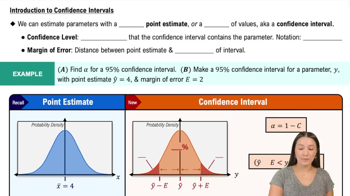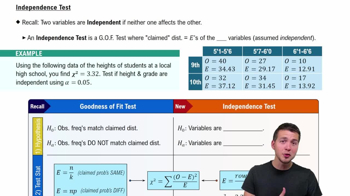Lightning Deaths The graph in Cumulative Review Exercise 5 was created by using data consisting of 242 male deaths from lightning strikes and 64 female deaths from lightning strikes. Assume that these data are randomly selected lightning deaths and proceed to test the claim that the proportion of male deaths is greater than . Use a 0.01 significance level. Any explanation for the result?
Table of contents
- 1. Intro to Stats and Collecting Data1h 14m
- 2. Describing Data with Tables and Graphs1h 55m
- 3. Describing Data Numerically2h 5m
- 4. Probability2h 16m
- 5. Binomial Distribution & Discrete Random Variables3h 6m
- 6. Normal Distribution and Continuous Random Variables2h 11m
- 7. Sampling Distributions & Confidence Intervals: Mean3h 23m
- Sampling Distribution of the Sample Mean and Central Limit Theorem19m
- Distribution of Sample Mean - Excel23m
- Introduction to Confidence Intervals15m
- Confidence Intervals for Population Mean1h 18m
- Determining the Minimum Sample Size Required12m
- Finding Probabilities and T Critical Values - Excel28m
- Confidence Intervals for Population Means - Excel25m
- 8. Sampling Distributions & Confidence Intervals: Proportion1h 12m
- 9. Hypothesis Testing for One Sample3h 29m
- 10. Hypothesis Testing for Two Samples4h 50m
- Two Proportions1h 13m
- Two Proportions Hypothesis Test - Excel28m
- Two Means - Unknown, Unequal Variance1h 3m
- Two Means - Unknown Variances Hypothesis Test - Excel12m
- Two Means - Unknown, Equal Variance15m
- Two Means - Unknown, Equal Variances Hypothesis Test - Excel9m
- Two Means - Known Variance12m
- Two Means - Sigma Known Hypothesis Test - Excel21m
- Two Means - Matched Pairs (Dependent Samples)42m
- Matched Pairs Hypothesis Test - Excel12m
- 11. Correlation1h 6m
- 12. Regression1h 50m
- 13. Chi-Square Tests & Goodness of Fit1h 57m
- 14. ANOVA1h 57m
9. Hypothesis Testing for One Sample
Steps in Hypothesis Testing
Problem 9.2.5b
Textbook Question
In Exercises 5–20, assume that the two samples are independent simple random samples selected from normally distributed populations, and do not assume that the population standard deviations are equal. (Note: Answers in Appendix D include technology answers based on Formula 9-1 along with “Table” answers based on Table A-3 with df equal to the smaller of n1-1 and n2-1)
Better Tips by Giving Candy An experiment was conducted to determine whether giving candy to dining parties resulted in greater tips. The mean tip percentages and standard deviations are given below along with the sample sizes (based on data from “Sweetening the Till: The Use of Candy to Increase Restaurant Tipping,” by Strohmetz et al., Journal of Applied Social Psychology, Vol. 32, No. 2).
b. Construct the confidence interval suitable for testing the claim in part (a).

 Verified step by step guidance
Verified step by step guidance1
Step 1: Identify the given data for both groups. For the 'No Candy' group: sample size (n₁) = 20, mean (x̄₁) = 18.95, standard deviation (s₁) = 1.50. For the 'Two Candies' group: sample size (n₂) = 20, mean (x̄₂) = 21.62, standard deviation (s₂) = 2.51.
Step 2: Use the formula for the confidence interval for the difference between two means when the population standard deviations are not assumed to be equal. The formula is: CI = (x̄₁ - x̄₂) ± t * √((s₁²/n₁) + (s₂²/n₂)), where t is the critical value from the t-distribution table based on degrees of freedom (df).
Step 3: Calculate the degrees of freedom (df) using the formula: df = ((s₁²/n₁ + s₂²/n₂)²) / (((s₁²/n₁)² / (n₁ - 1)) + ((s₂²/n₂)² / (n₂ - 1))). This will determine the appropriate t-value for the confidence interval.
Step 4: Find the critical t-value corresponding to the desired confidence level (e.g., 95%) and the calculated degrees of freedom. Use a t-distribution table or technology to find this value.
Step 5: Substitute the values for x̄₁, x̄₂, s₁, s₂, n₁, n₂, and the critical t-value into the confidence interval formula to compute the interval. Interpret the interval in the context of the problem to determine whether giving candy results in greater tips.
 Verified video answer for a similar problem:
Verified video answer for a similar problem:This video solution was recommended by our tutors as helpful for the problem above
Video duration:
4mPlay a video:
Was this helpful?
Key Concepts
Here are the essential concepts you must grasp in order to answer the question correctly.
Confidence Interval
A confidence interval is a range of values, derived from sample statistics, that is likely to contain the true population parameter. It is calculated using the sample mean, standard deviation, and sample size, along with a critical value from the t-distribution or z-distribution, depending on the sample size and whether the population standard deviation is known. In this context, constructing a confidence interval will help assess the difference in tip percentages between the two groups.
Recommended video:

Introduction to Confidence Intervals
Independent Samples
Independent samples refer to two or more groups that are not related or paired in any way. In this experiment, the tips from dining parties that received candy are independent of those that did not. This independence is crucial for applying statistical tests, as it ensures that the results from one sample do not influence the results from another, allowing for valid comparisons between the groups.
Recommended video:
Guided course

Independence Test
T-test for Independent Samples
A t-test for independent samples is a statistical method used to determine if there is a significant difference between the means of two independent groups. It is particularly useful when the population standard deviations are unknown and the sample sizes are small. In this case, the t-test will help evaluate whether the difference in mean tip percentages between the groups (with and without candy) is statistically significant.
Recommended video:
Guided course

Independence Test

 6:21m
6:21mWatch next
Master Step 1: Write Hypotheses with a bite sized video explanation from Patrick
Start learningRelated Videos
Related Practice
Textbook Question
